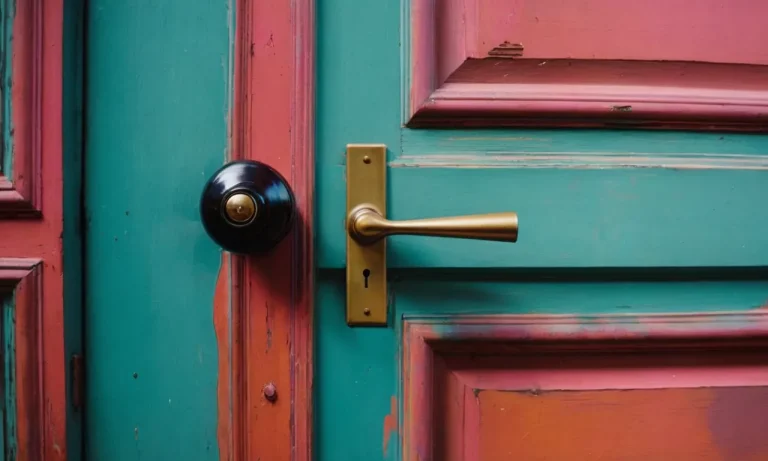Storm Doors Vs Screen Doors: Which Is Better For Your Home?
Installing a storm door or a screen door can help improve your home’s energy efficiency, security, and appearance. But how do you decide which type of door is right for your home? In this comprehensive guide, we’ll examine the key differences between storm doors and screen doors to help you make the best choice.
If you’re short on time, here’s a quick answer: Storm doors are more energy efficient and provide better protection from weather and insects. Screen doors allow for increased ventilation and visibility. Choose a storm door if insulation and security are top priorities.
Opt for a screen door if you mainly want ventilation and aesthetics.
What is a Storm Door?
A storm door is an additional door that is installed in front of an existing exterior door. It provides an extra layer of protection against the elements and can help improve energy efficiency in your home.
Storm doors typically have a full-length glass panel that can be replaced with a screen during warmer months, allowing for increased ventilation and natural light.
Storm Door Definition and Key Features
Storm doors are designed to withstand harsh weather conditions such as wind, rain, and snow. They are typically made of durable materials such as aluminum, steel, or fiberglass and are available in various styles and designs to complement the aesthetic of your home.
Key features of a storm door may include:
- Full-length glass panel
- Screen insert option
- Weatherstripping to prevent drafts
- Security features such as locks and deadbolts
- Adjustable ventilation options
Different Types of Storm Doors
There are several types of storm doors available, including:
- Full-view storm doors: These doors have a full-length glass panel that provides an unobstructed view of the outside.
- Mid-view storm doors: These doors have a glass panel that covers the bottom half of the door, with a solid panel on the top half.
- High-view storm doors: These doors have a glass panel that covers the top half of the door, with a solid panel on the bottom half.
Storm Door Materials
Storm doors can be made from various materials, each with its own benefits and drawbacks:
| Material | Benefits | Drawbacks |
|---|---|---|
| Aluminum | Durable, lightweight, low maintenance | Can dent or scratch easily |
| Steel | Strong, resistant to impact and forced entry | Can rust if not properly maintained |
| Fiberglass | Durable, resistant to warping and cracking | Can be more expensive |
Storm Door Benefits and Drawbacks
There are several benefits to installing a storm door:
- Improved energy efficiency: Storm doors can help reduce drafts and air leakage, leading to potential energy savings.
- Added protection: Storm doors provide an extra layer of security against break-ins and can help protect your primary door from damage.
- Increased natural light and ventilation: With the option to replace the glass panel with a screen, storm doors allow for increased airflow and natural light during warmer months.
However, there are also some drawbacks to consider:
- Cost: Storm doors can be an additional expense, especially if you opt for higher-end materials or features.
- Maintenance: Depending on the material, storm doors may require periodic cleaning, painting, or maintenance to keep them looking and functioning their best.
Ultimately, whether a storm door is right for your home will depend on your specific needs, budget, and climate. It may be helpful to consult with a professional or do further research to determine if a storm door is the best option for you.
What is a Screen Door?
A screen door is a door that is primarily designed to allow fresh air to flow into a home while keeping insects and debris out. It is typically installed in front of an exterior door and consists of a frame with a mesh screen.
Screen doors are a popular choice for homeowners who want to enjoy the benefits of natural ventilation without compromising on security or cleanliness.
Screen Door Definition and Key Features
A screen door is a lightweight door that is usually made of aluminum or wood, with a mesh screen panel that allows air to circulate while keeping bugs out. It is typically hinged and can be opened or closed like a regular door. Some key features of screen doors include:
- Mesh screen: The mesh screen is the defining feature of a screen door. It is made of a fine mesh material that allows air to pass through while keeping insects, leaves, and debris out.
- Hinges and handles: Like regular doors, screen doors are equipped with hinges and handles for easy opening and closing.
- Optional features: Some screen doors may come with additional features, such as pet doors, security locks, or retractable screens.
Different Types of Screen Doors
There are several types of screen doors available on the market, each with its own unique features and benefits:
- Traditional screen doors: These are the most common type of screen doors, featuring a full mesh screen panel that covers the entire door frame.
- Retractable screen doors: These doors have a retractable mesh screen that can be pulled across the doorway when needed and retracted when not in use, providing a clear view.
- Sliding screen doors: Sliding screen doors are designed to be installed alongside sliding glass doors or patio doors. They operate on a track system, allowing for easy opening and closing.
Screen Door Materials
Screen doors are available in a variety of materials, each with its own advantages and drawbacks:
| Material | Advantages | Drawbacks |
|---|---|---|
| Aluminum | Durable, lightweight, and low-maintenance | Can dent or scratch easily |
| Wood | Natural and aesthetically pleasing | Requires regular maintenance and can be prone to rot and warping |
| Vinyl | Durable, resistant to dents and scratches, low-maintenance | Limited color options |
Screen Door Benefits and Drawbacks
Screen doors offer several benefits for homeowners:
- Natural ventilation: Screen doors allow fresh air to flow into the home, improving indoor air quality and reducing the need for artificial cooling.
- Insect protection: The mesh screen keeps bugs, mosquitoes, and other pests out, allowing homeowners to enjoy their outdoor surroundings without the annoyance of insects.
- Energy efficiency: By allowing natural airflow, screen doors can help reduce the need for air conditioning or fans, resulting in potential energy savings.
However, screen doors also have some drawbacks:
- Less security: Screen doors are not as secure as solid doors and may be easier to break into.
- Maintenance: Depending on the material, screen doors may require regular cleaning, painting, or repairs to maintain their appearance and functionality.
- Cost: Screen doors can vary in price depending on the material and features, and may require professional installation.
Ultimately, the choice between a storm door and a screen door will depend on your specific needs and preferences. It is advisable to consider factors such as climate, security requirements, and budget before making a decision.
Storm Door vs Screen Door: Key Differences
Appearance and Visibility
When it comes to appearance, both storm doors and screen doors offer different options for homeowners. Storm doors are typically made of durable materials like aluminum or steel, and they often have glass panels that can be replaced with screens during the warmer months.
This allows for better insulation and protection against the elements. On the other hand, screen doors are made primarily of mesh screens, providing a more open and airy feel. They allow for better visibility and airflow, but may not offer the same level of protection against harsh weather conditions.
Durability and Weather Resistance
In terms of durability and weather resistance, storm doors are generally considered to be superior. They are designed to withstand heavy winds, rain, and other harsh weather conditions. Screen doors, on the other hand, are more susceptible to damage and may need to be replaced more frequently.
Storm doors often come with features like weatherstripping and reinforced frames, which offer better insulation and protection against drafts.
Installation and Maintenance
When it comes to installation and maintenance, both storm doors and screen doors have their advantages. Storm doors are typically more complex to install, as they require additional hardware and may need to be customized to fit the dimensions of the entryway.
However, once installed, they generally require less maintenance. Screen doors, on the other hand, are easier to install and can be easily replaced if damaged. They also require regular cleaning and maintenance to keep the screens in good condition.
Energy Efficiency and Temperature Control
When it comes to energy efficiency and temperature control, storm doors have the upper hand. The additional layer of insulation provided by storm doors helps to reduce drafts and keep the interior of the home more comfortable.
This can result in lower energy bills and a more consistent indoor temperature. Screen doors, on the other hand, allow for better airflow and ventilation, which can be beneficial during the warmer months but may not provide the same level of insulation during colder weather.
Insect Protection
Both storm doors and screen doors offer some level of insect protection, but there are differences in effectiveness. Storm doors with screens can help keep insects out while still allowing for ventilation.
However, screen doors may have smaller mesh sizes and therefore offer better protection against smaller insects like mosquitoes. It’s important to consider the specific needs and concerns regarding insect protection when choosing between a storm door and a screen door.
Security and Safety
When it comes to security and safety, storm doors are generally considered to be more secure. They often come with features like deadbolts and reinforced frames, offering an additional layer of protection against intruders.
Screen doors, on the other hand, are typically less secure and may only provide a deterrent rather than a strong barrier. It’s important to consider the level of security required for your home when choosing between a storm door and a screen door.
Cost Comparison
When comparing the costs of storm doors and screen doors, it’s important to consider both the upfront cost and the long-term maintenance expenses. Storm doors are generally more expensive to purchase and install, especially if customization is required.
However, they often have a longer lifespan and require less maintenance. Screen doors, on the other hand, are typically more affordable upfront but may need to be replaced more frequently. It’s important to weigh the initial cost against the long-term expenses when making a decision.
When to Choose a Storm Door vs Screen Door
Choosing between a storm door and a screen door depends on several factors that are unique to each homeowner. Understanding the benefits and considerations of each option can help you make an informed decision that suits your specific needs.
Prioritizing Energy Efficiency and Weather Protection
If you live in an area with harsh weather conditions, such as extreme heat or frequent storms, a storm door may be the better choice for you. Storm doors are designed to provide an extra layer of insulation and weather protection, helping to keep your home comfortable and energy-efficient.
They are typically made with durable materials and can withstand strong winds and heavy rain.
On the other hand, if you live in a mild climate and want to maximize natural ventilation and airflow, a screen door may be more suitable. Screen doors allow fresh air to circulate throughout your home while keeping bugs and debris out.
Wanting Maximum Ventilation and Visibility
If you enjoy the feeling of fresh air flowing through your home and want maximum visibility of your surroundings, a screen door is the way to go. Screen doors are made with mesh or wire panels that allow air to pass through freely, providing excellent ventilation.
They also offer unobstructed views of your outdoor space, allowing you to enjoy the scenery.
Storm doors, on the other hand, typically have glass panels that limit airflow and obstruct the view to some extent. However, some storm doors come with interchangeable glass and screen panels, giving you the option to switch between the two depending on the season or weather conditions.
Concerned About Safety and Security
If safety and security are top priorities for you, a storm door may be a better choice. Storm doors are generally more secure than screen doors as they are made with sturdy materials and often feature additional locking mechanisms. They provide an extra layer of protection against intruders.
Screen doors, while not as secure as storm doors, are still a popular choice for many homeowners. They offer a level of security by acting as a barrier against unwanted pests and preventing children and pets from wandering outside.
Seeking Low Maintenance and Durability
When it comes to maintenance and durability, storm doors tend to require more upkeep than screen doors. They may need periodic cleaning and maintenance to keep them functioning properly. However, storm doors are typically built to withstand the elements and can last for many years when properly cared for.
Screen doors, on the other hand, are relatively low maintenance. They may require occasional cleaning and repair of the mesh or wire panels, but overall, they are less demanding in terms of upkeep.
Matching a Certain Architectural Style
If you have a specific architectural style or aesthetic preference for your home, both storm doors and screen doors come in a variety of designs and finishes to match your needs. Whether you prefer a traditional or modern look, you can find options that complement your home’s style.
Ultimately, the decision between a storm door and a screen door depends on your individual preferences and the specific needs of your home. Consider factors such as weather conditions, desired ventilation, safety concerns, maintenance requirements, and architectural style to make the best choice for your home.
Conclusion
Storm doors and screen doors each have their own advantages. Storm doors excel at insulation, durability, and protection from weather and pests. Screen doors provide stellar ventilation and visibility while complementing a variety of home styles.
Consider how you want to use your door and what’s most important for your home and climate before deciding between a storm door vs screen door.







